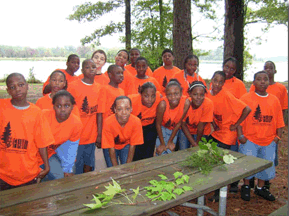
FAWN is an acronym for Forestry Awareness Week Now. This is a program for sixth graders to learn about Alabama’s natural resources and environmental issues. The lessons are taught by resource professionals from forest industry and state and federal agencies, and knowledgeable, engaged forest landowners. The goal of the lesson is to present the science-based facts and truth about Alabama’s tremendous forest resource and its importance to their lives.
FAWN originated in Louisiana and had its Alabama debut in Morgan County in May 1994. Since then it has spread to five other counties and appears to be on the threshold of even greater expansion. Although it is manpower intensive, FAWN is a fairly simple program to conduct and its benefits in educating our society about forestry and other resource issues are incalculable. Most important, the students enjoy it and really learn important things about their relationship with our forests from a conservation or wise-use perspective.
The county forestry planning committee has proven to be the best vehicle to start a local FAWN program. Cooperation between the planning committee and the local city or county school board is critical and so far has been very easy to secure. Once this program has been put on in a local school district, the momentum has been established for a yearly repeat. The schools become active and willing partners.
FAWN takes place in a forest environment, usually one with a half-mile or so round robin hiking trail. Seven or eight learning stations are set up at intervals along this trail and manned by resource professionals. Learning stations usually include forest management, forest products, forest history, soils, wildlife, tree and plant identification, water quality and Project Learning Tree (PLT).
The students, all sixth graders from the local school system, are divided into seven or eight groups matching the number of learning stations. They are usually in classroom units of 25 or 30 students per group. Each group is given a different colored tee shirt with the FAWN logo to keep them distinct. They then move around the trail, stopping at each learning station for 20-25 minutes. Each group is accompanied by a “trail guide” who acts as a timekeeper and teacher’s aide.
The stations provide a positive, hands-on, interactive learning experience for the students. They will feel soil, count tree rings, handle a snake, do several PLT exercises, play learning games and be educated about why they need trees and why management is necessary to keep the products coming while protecting the intrinsic values of the forest.
They will learn to see the forest differently, not only as a beautiful place full of trees where animals live, but as an integral part of their everyday lives. In addition, the teachers are given resource materials and names of people they can call on to continue their education about important environmental issues. This will reinforce the message the students receive at FAWN.
To make FAWN as successful as it can be, by spreading it throughout Alabama, it will take a major grassroots commitment by the professional forest resource community. It takes about 30 people per day to run the program and, at most, 200 students per day can attend. To provide this valuable learning tool to each school district in the state on an annual basis will involve many of us. The results are proven, and the need is there; we must be committed to fulfilling this need. If you would like more information, contact your local Alabama Forestry Commission office.